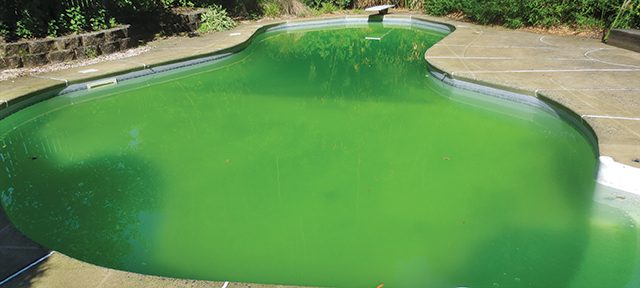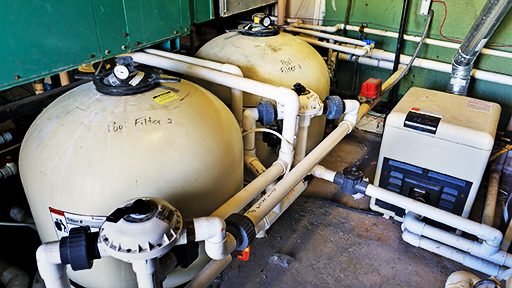WHEN IT COMES TO THE OCEAN, we know when to go and when to stay away. If it is standard practice to check conditions before a dive, shouldn’t we ask a few basic questions before diving into a pool?
Years ago I ran a pool at an athletic club and someone asked, “Why do we need all those chemicals?” Without them, the pool could contain bacteria, viruses, and other waterborne illnesses (WBIs). The challenge is keeping the balance in an ever-changing environment. Any pool built for public use, whether at an aquatic complex or a hotel, should have a certified pool operator (CPO) who has the knowledge and training to maintain the proper equilibrium. At the very least, a staff person should understand the information below and be able to answer questions about their pool.
Testing Pool Chemicals

Photo courtesy of Pool Operation Management
There are no national standards for pools. Some states govern pool regulations, while others merely offer a pamphlet. Testing standards vary wildly from state to state, but common sense suggests that testing pool chemicals at least three times a day is the minimum effort. If many people use the pool, more frequent testing would be in order.
Public CPOs usually begin by testing for free chlorine and total chlorine. A difference in those numbers indicates chloramines, which must be eliminated. Free chlorine should be between 1 and 4 parts per million (ppm) for the average pool, with no chloramines. Next is a pH test, which should read between 7.2 and 7.8 — slightly alkaline to make the chlorine most effective. Total alkalinity should be between 80 and 120 ppm.

Photo by Jeremy Storton
Operators also test for calcium hardness, often described as “hard” or “soft” water, which measures the dissolved calcium and magnesium and should be 200 to 450 ppm. Cyanuric acid should be 30 to 50 ppm.
Pool Chemicals for Swimmers
Pools typically use chlorine or bromine, usually via inline feeders, to sanitize the water after it has been strained and passed through a filter. There is a difference between sanitization and sterilization: It’s not necessary to remove all bacteria and viruses. Like our own immune systems, balance is the key.
Chlorine

Photo courtesy of Pool Operation Management
When we think about pools, we think about free chlorine. Chlorine at the appropriate level effectively kills microbes and has been the standard for many years. If chlorine is too high, it can irritate skin and mucous membranes. If it is too low, the pool will get cloudy, and WBIs will have more opportunities to harm swimmers.
Chloramines
Free chlorine is what destroys organic matter. When it combines with other compounds such as sweat, oils, lotions, or urine, chlorine loses efficiency and becomes chloramines. Showering before entering a pool helps prevent that process. The familiar aroma of an indoor pool is from chloramines, which are also responsible for burning our eyes after swimming without goggles. Chloramines tend to volatilize and will leave the facility if the pool is well ventilated. If not, these particles will fall back into the pool, so the CPO will need to shock the pool with a high dose of more chlorine and ventilate the area.
Bromine
Bromine Bromine is more efficient and effective than chlorine and a little easier on our bodies. It is more unstable in sunlight, however, so it is more common for use in indoor pools. Bromine may have a bit of chlorine added for a sanitizing boost. The problems found when bromine is too high or low are similar to those with chlorine. With either bromine and chlorine, if the water is cloudy, if the indoor facility smells like either product, or if your eyes burn after swimming without goggles, there is a problem. In this instance, get out of the water and let the facility know.
Cyanuric Acid
Stability in the presence of ultraviolet light is an issue for both chlorine and bromine. Chlorine, at least, has a solution. Cyanuric acid (CYA) acts like a sunblock for chlorine to slow its breakdown, so it’s often present in outdoor pools but at low enough levels that we’ll not notice, and it won’t affect us. If CYA levels are too high, the chlorine won’t be as effective, and the CPO will have to dilute it with fresh water to provide balance.
Sodium Thiosulfate
Sodium thiosulfate neutralizes chlorine when it is too high or when testing. To address persistent high chlorine levels, a CPO can drain and refill the pool to dilute the chlorine and then rebalance the rest of the chemicals, but using sodium thiosulfate to reduce the chlorine will save time and effort.
Water Balance
A pH of 7.4 is ideal for pools, and chlorine is most effective at protecting us from WBIs at this level. The acidity of water with a low pH can strip away body oils, irritate skin and mucous membranes, and break down pool equipment. High pH can cause cloudy water, which is a problem if we can’t see the bottom of the pool and a swimmer is missing.
Total alkalinity is a buffer that eliminates large pH swings — if the alkalinity is balanced, the pH will follow. Broadcasting — or tossing — sodium carbonate (soda ash) or sodium bicarbonate (baking soda) into a pool can raise pH and alkalinity when they get too low. Sodium bisulfate and muriatic acid can reduce high pH and alkalinity. Although muriatic acid can be caustic and corrosive, it’s rarely a problem if the pool is balanced. Pool operators can pour these chemicals directly into a pool with no bathers or dilute them in a bucket and add them.
Whether your pool experience is doing your dive training or enjoying a jacuzzi after a cold dive, there is a world of pool knowledge with which you can familiarize yourself. We should ask about the pools we use so we know what we are getting ourselves into. The adage of “know before you go” applies to more than a new dive spot.
Special thanks to Trevor Sherwood, owner and pool instructor of Pool Operation Management, for contributing his knowledge to this article.